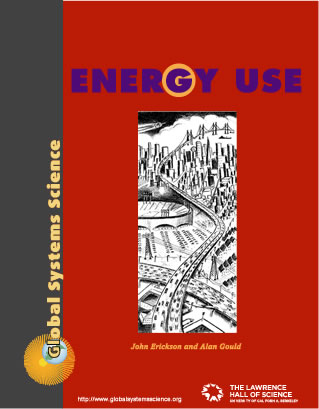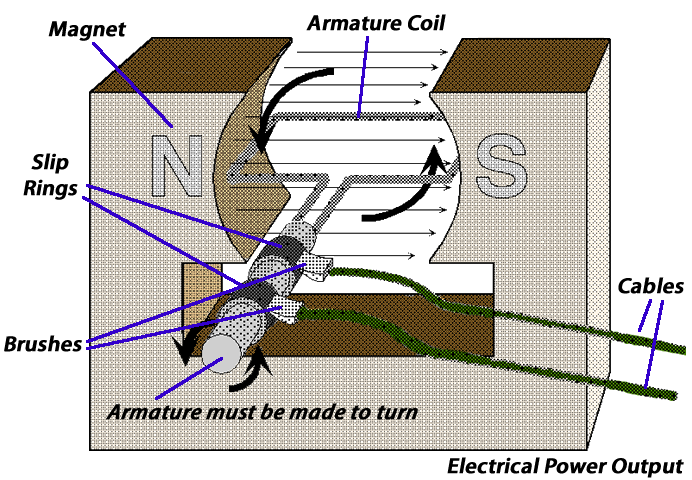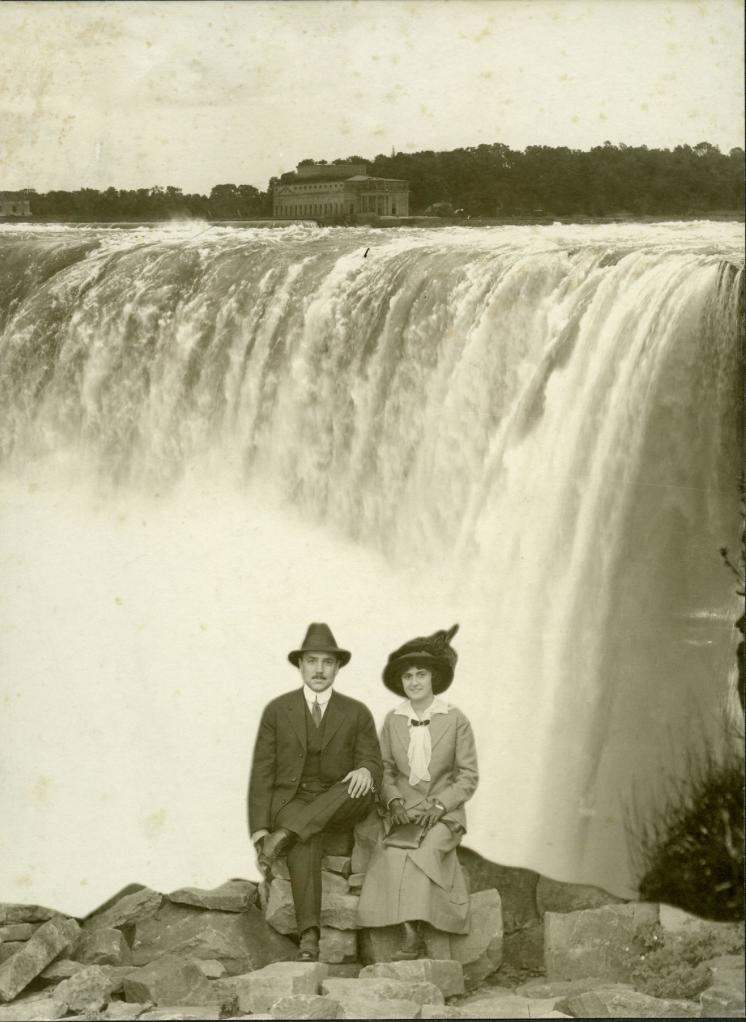EU2. Energy Basics

Chapter 2
In order to make intelligent choices about energy it’s important to understand what energy is. Surprisingly, energy is not easy to define; and you are likely to find different definitions in different textbooks. A useful definition for energy is “that which makes things happen.” Can you see energy? Actually, all you can see is energy, because light itself is energy. Our other senses (touch, hearing, taste, and smell) also depend on the interaction of energy with our bodies. Energy is a part of every moment of our experience. See if you can apply this definition in the following investigation.

EU2.1. Investigation:
Doing Work to Create Electricity
Use magnets and coils of wire to generate electricity.
I. Converting Motion Energy to Electrical Energy

Image courtesy of www.wikipedia.org
A number of different answers are possible for where you can find energy in the system consisting of you, the coil, meter, and magnet. Certainly there is energy in the movement of your hand. There must also be energy in the coil while it is being moved near the magnet, because it makes the needle in the meter move.
In 1831, Michael Faraday connected a loop of wire to an electric meter. He noticed that the pointer on the electric meter jumped when he moved the coil of wire near a magnet, just as yours did in the previous activity. This discovery led to the invention of the electric generator, which produces nearly all of the electricity that lights our cities and powers modern industry.
What happens inside the coil of wire when you move it near the magnet? One way to think about what is happening is to visualize tiny particles—called electrons—that are free to move through the coil of wire. The electrons are pushed and pulled by the magnet. When these electrons move in the wire, they cause the needle in the meter to move. The flow of electrons through the wire is electrical energy, or simply electricity.
Notice that neither the magnet nor the coil alone can produce electrical energy—it takes the movement of the coil by your hand to produce the electrical energy. Motion energy is called kinetic energy. In the previous activity you converted kinetic energy into electrical energy.
Let’s look inside an electric generator and see how it converts kinetic energy to useful electrical energy. Keep in mind that although it looks complicated, an electrical generator works on the same principle as the system you already explored—you, the coil, meter, and magnet.
Inside An Electric Generator
Magnets turn up often in modern life. You find them stuck to refrigerators, in telephones, televisions, motors, speakers, recording tape, credit cards, and bank cards. Magnets seem to act like magic. All magnets have North and South poles that attract each other, but South poles repel South poles, and North poles repel North poles.

When you pour iron filings on a piece of paper, you can see the pattern of the magnet’s magnetic field.
Photo Via Wikimedia Commons; http://commons.wikimedia.org/wiki/File%3AMagnet0873.png
Scientists use the concept of a field to describe the force a magnet can exert in the space surrounding it. A magnetic field is invisible, but flakes of iron around a magnet will line up to show the direction of the field lines.
You may be familiar with a small electric generator used on bicycles to power a light. The generator is attached to the bicycle so that peddling turns not only the bicycle wheel, but also turns a coil of wire inside of a magnet. The work of peddling the bike produces the electricity to power the light. Here’s how it works.

Inside the generator, a magnet creates a strong magnetic field. A coil of wire called the armature coil spins in the magnetic field. As the wire moves through the field, the electrons in the wire are forced around the coil by the magnetic field. During one half of a turn the electrons are pushed one way and during the other half of the turn the electrons are pushed the other way. This pushing of electrons is how the generator produces electricity.
In order to get electrical power from the generator, the armature coil must be connected to cables. There is one small difficulty. The armature is always turning. If the cables were connected directly to the armature coil they would get twisted very quickly. Instead, the wires at the ends of the coil are connected to slip rings on the shaft of the armature. The cables that carry current from the generator are connected to brushes that rub against the slip rings as the armature turns. Can you find the slip rings and brushes on the diagram on this page?
The diagram of “An Electric Generator” above is simplified to show the principles of a generator. Here are some ways a real generator is different from the one in the diagram.
- The diagram shows a single loop of wire in the armature coil. In the coil of a real generator the wire is wrapped around many times.
- The armature coil in a real generator is also wrapped around a core of iron to intensify the magnetic field.
- The armatures of most large generators have more than one coil, each one in a different position. That way one generator can act as several separate sources of electrical power.
- The magnet in a large generator is an electromagnet. It consists of coils of wire, called exciter coils, to create a large magnet and the large magnetic field.

EU2.2. Investigation:
Using Electricity to Do Work
Can you force a coil to move by putting electricity into it?
II. Avoiding Confusion
We use a lot of energy-related terms in everyday language. That sometimes makes it difficult to understand the precise way these words are used in science. For example, compare the meaning of the terms work and power in these two sentences. What is the different meaning of the word in each case?
- Leonardo’s painting “Mona Lisa” is such a magnificent work it has the power to move people to tears.
- The work of peddling the bike produces electricity to power a light.
In sentence (1) we can figure out what the terms “work” and “power” mean from the context. In sentence (2) the same terms have the following specific meanings:
Work refers to the amount of energy expended when a force is exerted for a certain distance. For example, twice as much work is done if you peddle your bike twice as far. Twice as much work is also done if you push twice as hard on the peddles for the same certain distance.
Power is the speed, or rate, at which energy is converted from one form to another. A ten-watt bulb in your bicycle headlight converts electricity into light energy twice as fast as a five-watt bulb. It is therefore important not to put too high a wattage bulb into your headlight, which will require more electricity to stay lit than a lower wattage bulb, so you don’t have to work so hard to keep it lit.
Energy is defined in this book as that which makes things happen. Work is a kind of energy; so is light and electricity.
Kinetic energy is energy of motion.
Potential Energy is one more kind of energy you need to know. Potential is another word that has different meanings in everyday language. We can talk about someone’s potential—meaning what they could achieve. In science, potential energy is stored energy. There are many different kinds of potential energy. When you pick up a stone you are increasing its potential (gravitational) energy. Let go and it turns into kinetic energy as it falls. Batteries hold potential chemical energy. Connect the terminals of a battery with a wire and light bulb—you turn some of the battery’s potential (chemical) energy into heat and light energy. In the next activity you’ll turn potential chemical energy into kinetic energy.
III. AC/DC
When you measure the current from a battery, the reading on the meter remains steady. Electrons flow in one direction through the wires pushed by a steady force. That kind of current is called direct current or DC.

via Wikimedia Commons
In the Lab Investigation “Doing Work to Create Electricity,” when you moved the wire in the field of a magnet, its position was changing and the current was rising and falling, or even reversing direction. Producing DC with magnetism is a tricky job, but it is fairly simple to use magnetism to generate a current that alternates back and forth in a regular way. This is called alternating current, or AC.
In an AC power system the electrons do not flow very far before they stop and flow the opposite way. Electric power from a standard outlet is AC in which the current reverses direction 60 times per second.
IV. Conservation of Energy
Energy is never created or destroyed. When a battery runs down, people speak of energy being “used up,” but “used up” energy has not disappeared. It has been converted from one form of energy to another. This is called the Law of Conservation of Energy. This is one of the most important ideas in physics, and we will see it again later in this book.
V. Conclusion
When we use energy for our own purposes, we are really transforming energy from one form to another. If we trace back these energy transformations to their sources, we find nearly all the energy people use to heat and light their homes, to run their cars, or produce the billions of products we use everyday, comes from stored chemical energy—energy stored in the ground for millions of years. We’ll learn about these sources of energy, called “fossil fuels,” in the next chapter.

EU2.3. Investigation:
Energy Transformations
One of the major points of this chapter is that energy can take many different forms. Everyday we encounter situations in which one form of energy is being transformed into another form of energy.
Consider this sequence of energy transformations. Energy arrives on Earth in the form of sunlight. This light energy is converted to heat energy as it warms up water. The heat causes evaporation and the water is lifted up into the atmosphere. When the water is lifted into the air it gains potential gravitational energy. When it comes down, that energy is converted to kinetic energy of billions of individual raindrops. Those raindrops may join the river that flows over Niagara Falls.

Couple posing
at Niagara Falls
via Flickr
Some of the kinetic energy of the water falling over the falls is converted to electrical energy in huge generators. The electrical energy produced by the generators power the lights (giving off light and heat energy) some newlyweds use to see and eat their dinner.
As the newlyweds admire the falls during their honeymoon they are busy converting potential chemical energy from food from their dinner into thoughts (chemical energy), physical movement (kinetic energy), and body warmth (heat energy).
These are the forms of energy we have mentioned so far:
- Heat Energy
- Gravitational Energy
- Electrical Energy
- Light Energy
- Chemical Energy
- Potential Energy
- Kinetic Energy
- Nuclear Energy
For each transformation, write down what form of energy it is and what form of energy it becomes.
- A skateboarder rolls down a hill.
- A car fills up at a gas station and drives across country.
- An electric guitarist plays a D-flat minor chord at a rock concert.
- A group of people go to the top of the Empire State Building in an elevator.
- A girl throws a paper airplane.
- A kettle of water boils and whistles on a gas stove.
- A hydrogen bomb explodes.
- A fan runs on batteries.
- A flashlight shines down a dark tunnel.
- A building is demolished with carefully placed sticks of dynamite.
Try making up a few of your own energy transformation “action sentences” and challenge your fellow students to identify which form of energy changes into which other form of energy.

